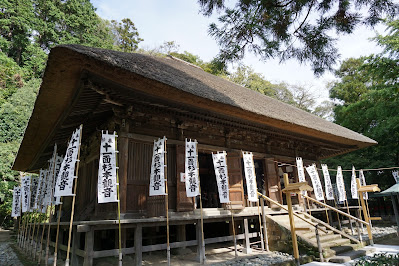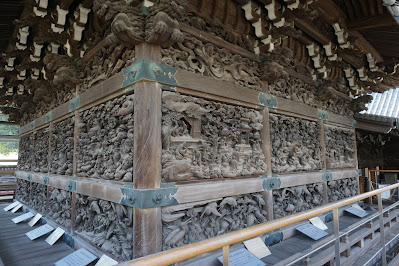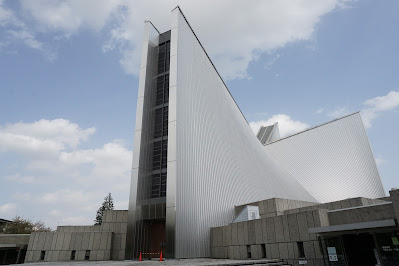Monday, November 8, 2021
Time Travel to Kawagoe
Sunday, October 24, 2021
Photogenic Kamakura
Kamakura is a popular daytrip destination for both locals and tourists. It is just a little over an hour train ride from Tokyo, yet it presents a completely different scenery.
Surrounded by mountains and facing the ocean, Kamakura was chosen as the the seat of the samurai government at the end of the 12th century and so remained for 140 years. Later it was developed as a sophisticated resort and residential town and has been loved by intellectuals.
Kamakura has too many sites to cover, so let's mention just a few photogenic spots.
1. Hokoku-ji Temple
The zen temple was established in 1334 and is known for its beautiful bamboo forest which has 2,000 Moso bamboos. You can walk through the garden, and have matcha green tea at the tea shop facing the forest. A tranquil, relaxing moment. The bamboos remain green all through the year.
2. Sugimoto-dera Temple
Built in 734, Kamakura's oldest temple has subdued colors but but presents magnificent atmosphere.
The Nioh statues are said to be the works of Unkei.
The iconic moss stairs leading to the main building are not in use anymore (because it is obviously slippery!) You can take stairs that run parallel to them.
The thatched main building is awesome.
3. Sasuke Inari Shrine
The shrine sits quietly in a residential area. The tunnel of red torii gates leads up to the main shrine.
The precinct is filled with numerous figurines of white fox, which are believed to be the God's messengers.
It is said that the Gods of the shrine bring mercy to people who pray for career success, good matchmaking, and their pets' happiness. Wide-ranged benefits.
Kamakura is especially popular in the seasons of cherry blossoms (spring) and autumn colors, but it has beauty in every season. If you have a free day in Tokyo, a short excursion is worthwhile.
Saturday, October 16, 2021
Sawanoi - A Sake Brewery in Tokyo
Tokyo may not be among Japan's top sake producing regions, but it does have several sake breweries in the suburbs that are accessible from the center of the metropolis.
One of them, Sawanoi is in the Okutama area and sits along Tama River. The sake brewer was established in 1702, nearly 320 years ago. It has a longer history than many Champagne maisons in France!
If you walk from the nearby Sawai Station, you will notice a slight sweet aroma of malt in the air. Your journey into the sake world has already begun.
The Sawanoi Garden complex includes restaurants, shops and a tasting bar, but what is likely to get your attention first is the clear water stream down the slope. Good sake requires good water. At this privileged location, you can soak in the beautiful scenery of the river surrounded by mountains, and can even enjoy a hike along the trail.
The sakagura (sake factory) tour is provided free of charge and requires pre-booking as of Oct. 2021. The guide leads a small group into the factory. There are no windows that would let sunlight in, and it feels a little cooler than outside. You may recall wine or Champagne cellars. Some huge tanks hold over 8,000 litters of sake each.
The mother water is taken not direct from the ample river water but from the natural well deep inside a cave. Slowly coming out through the thick ancient bedrock, the spring water is rich in minerals.
Though most sake is sold and consumed fresh, here they also have aged sake. Some are over 20 years old. The vintage sake is amber colored and has a unique aroma.
It takes only 1.5 hours of train ride from central Tokyo. A pleasant day trip to fully enjoy both nature and good drink.
Friday, October 8, 2021
Rikugien Garden
Rikugien Garden is another magnificent Japanese garden in Tokyo. It was built by Yoshiyasu Yanagisawa, a retainer of the 5th Tokugawa Shogun Tsunayoshi, and took 7 years to build at the turn of the 17th and the 18th centuries.
The garden is a short walk from Komagome Station. It has a pond in the center surrounded by trees and walking trails. Like many other gardens built by daimyo (local lords) of the Edo period, it represents a natural mountain scenery condensed in the premises.
The large weeping cherry tree near the entrance gate bears beautiful pink blossoms in spring. The picture is featured on the entrance ticket.
Walking along the trail, you will encounter a small waterfall as if you found it deep in the mountain.
It is recommended that you stop at the Fukiage tea house along the pond and appreciate the view, sipping matcha green tea and tasting traditional sweets.
Aside from the cherry blossom season, autumn is also a great time to visit the garden for the beautiful colored leaves. At the time of my visit early October, some leaves were just starting to turn red.
From the corner called Deshio-no-Minato, you can view the whole garden with no modern buildings in sight.
The garden is a perfect place for a short walk and a trip into a small isolated universe.
Wednesday, July 7, 2021
The Wood Carvings of Shibamata Taishakuten Temple
Shibamata is an neighborhood at the eastern edge of Tokyo. It is known as the hometown of a 20th-century movie character "Tora-san" and has a nostalgic atmosphere that remains unchanged for decades.
By walking along the main street lined with traditional "kusa dango" (tansy sweets) shops, you will arrive at the Shibamata Taishakuten Temple.
The admission fee to the Chokoku Gallery also gives you access to the Suikeien Garden. You will walk along the corridor that surrounds the garden.
A nice short trip from the center of the metropolis for a change of pace.
Saturday, July 3, 2021
Higo-Hosokawa Garden
In Tokyo's quiet Mejirodai neighborhood lies the Higo-Hosokawa Garden. It is a public garden managed by the local municipality. It used to belong to different samurai families during the Edo Period and the last owner was the Hosokawa family from Higo (current Kumamoto Prefecture,) hence the name.
The traditional-styled garden has a large pond in the center surrounded by hills and walking trails. It uses the changes of elevation to represent real mountains, creating a downsized natural scenery. You would also find spring water along the trails and wonder if you are hiking in a mountain of some countryside.
Admission to Higo-Hosokawa Garden is free. It is close to Hotel Chinzanso Tokyo and St. Mary's Cathedral. In spring, the adjoining Kanda River will be lined with cherry blossoms creating a lovely promenade for a walk, but the garden has its charm for all seasons.
 |
| photos taken in April 2021 |
Friday, July 2, 2021
St. Mary's Cathedral by Kenzo Tange
St. Mary's Cathedral is in Bunkyo Ward, Tokyo and is in walking distance from the subway Gokokuji Station. The neighborhood is surrounded by a number of schools and universities. It is also close to the Higo-Hosokawa Garden that used to belong to a feudal lord family.
The cathedral was designed by the late architect Kenzo Tange and was built in 1964. It does not look like any other church. No cross is attached but the building itself is cross-shaped. You will see it once inside.
The interior of the cathedral is simple, dark and solemn, looking even like a secret fort. When you look up, you will see a cross-shaped top light and realize that you are in a church. Photography is not allowed inside, so please visit the cathedral yourself and see the futuristic architecture.
Thursday, July 1, 2021
The Imperial Palace and the Lotus Moat
Amid the rain season in Tokyo, a walk along the Imperial Palace moat turned out to be a imaginary exploration into a lush exotic forest.

Summer is around the corner.




































